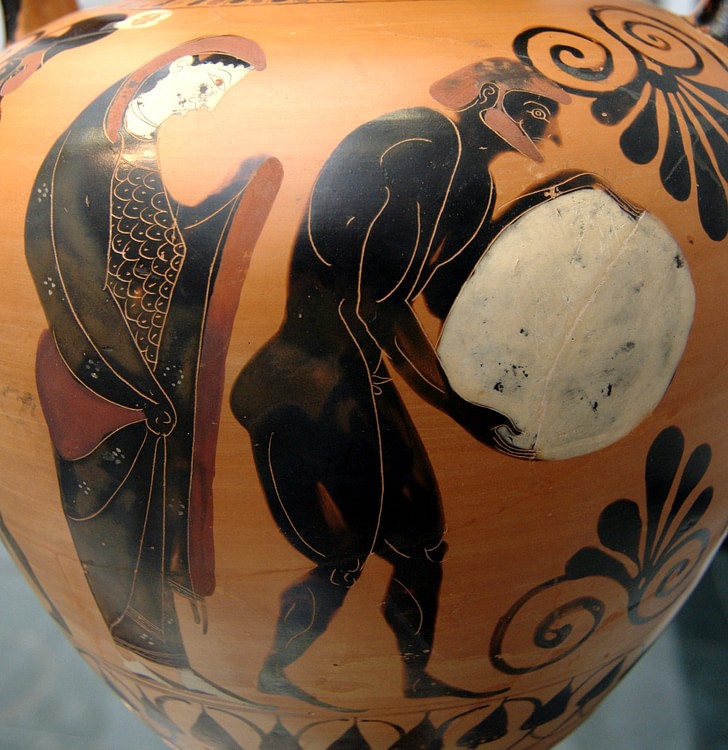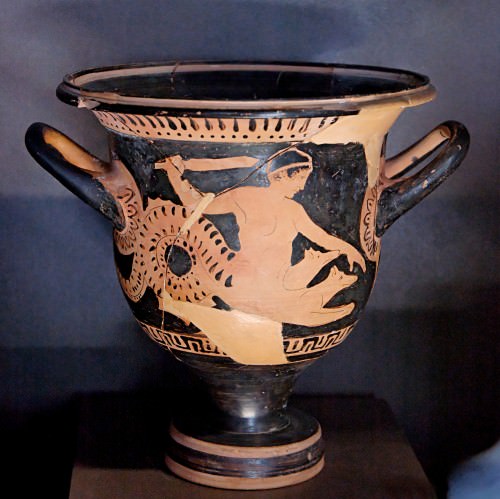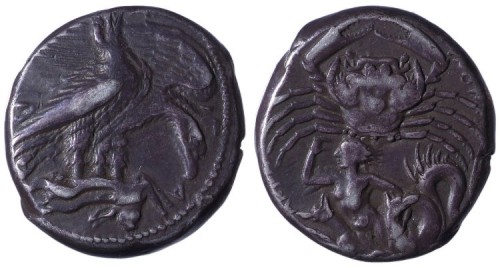Sisyphus › Scylla and Charybdis » Ancient origins
Articles and Definitions › Contents
- Sisyphus › Who Was
- Scylla and Charybdis › Who Was
Ancient civilizations › Historical and archaeological sites
Sisyphus › Who Was
Definition and Origins

Sisyphus (or Sisyphos) is a figure from Greek mythology who, as king of Corinth, became infamous for his general trickery and twice cheating death. He ultimately got his comeuppance when Zeus dealt him the eternal punishment of forever rolling a boulder up a hill in the depths of Hades. Founder of the Isthmian Games and grandfather of Bellerophon, he is nowadays best remembered as a poignant symbol of the folly of those who seek to trifle with the natural order of things and avoid humanity's sad but inescapable lot of mortality. The adjective Sisyphean denotes a task which can never be completed.
CHEATING DEATH
In Greek mythology, the story of Sisyphus has multiple and often contradictory versions with embellishments added over time so that the only point of certainty is his terrible punishment. He was the son of Aeolus, described by Homer as a human who rules the winds. Sisyphus is credited with being the founder and first king of Corinth. He gained infamy for his trickery and wicked intelligence, but his greatest feat was to cheat death and Hades himself, not once but twice, thus living up to Homer's description of him as "the most cunning of men" ( Iliad, 6:153). In the first episode the king, after dying and descending into Hades, audaciously managed to capture Thanatos, the personification of Death, and chain him up so that no humans died thereafter. Only the intervention of Ares resolved the crisis, and Death was freed to pursue his natural work.
THE KING OF THE GODS MADE SURE THAT HUMANS WOULD NOT BE ENCOURAGED BY THE FEATS OF THE TRICKSTER SISYPHUS.
The second episode proved more successful. After dying for the second time and once again finding himself in the shady underworld, Sisyphus persuaded Hades to let him out back into the bright realm of the living. For the king had cleverly arranged for his wife not to provide the usual offerings and sacrifices that were due on her husband's death. Working on the kind-hearted wife of Hades, Persephone, the king pleaded that if he were released he would be able to instruct his wife to carry out the proper rituals and all would be well. On his release, Sisyphus, naturally, made no attempt to return to Hades but lived to a ripe old age, largely thanks to Death now not wanting to go anywhere near him following his previous experience of being put in chains.
ZEUS' PUNISHMENT
When the king died yet again, there was to be no escape for him this time as Zeus himself now intervened. The king of the gods made sure that humans would not be encouraged by the feats of the trickster Sisyphus. His fate would have to be long and tedious. In Homer's Odyssey the hero Odysseus descends into Hades and, coming across many a fallen hero, he sees Sisyphus and his eternal punishment:
Then I witnessed the torture of Sisyphus, as he wrestled with a huge rock with both hands. Bracing himself and thrusting with hands and feet he pushed the boulder uphill to the top. But every time, as he was about to send it toppling over the crest, its sheer weight turned it back, and once again towards the plain the pitiless rock rolled down. So once more he had to wrestle with the thing and push it up, while the sweat poured from his limbs and the dust rose high above his head. ( Odyssey, Book 11:593)
AUTOLYCUS & OTHER ASSOCIATIONS
In another tale, Sisyphus used his cunning to finally catch Autolycus, the grandfather of Odysseus and infamous thief.Sisyphus cleverly attached lead tablets to the feet of his own cattle herd, and so when Autolycus stole them, Sisyphus was able to follow the tracks and catch the thief red-handed. The tablets had all been inscribed with the words 'Autolycus stole them.'

The Punishment of Sisyphus
Sisyphus was also the founder of the famous Isthmian games of Corinth, held every two years in honour of Poseidon, and one of the four major Panhellenic games which included the Olympic games. Sisyphus was succeeded as king of Corinth by his son Glaucus – he who was ripped to pieces by his own flesh-eating horses – and then his grandson Bellerophon, whose winged horse Pegasus became a symbol of the city and a feature of Corinthian coins.
SISYPHUS IN ART
The Underworld was a relatively rare subject for Greek vase painters, but there are a dozen or so vases from the 6th century BCE showing Sisyphus. On one Athenian black-figure amphora, dating to c. 510 BCE and now in the British Museum, a scene of Sisyphus' punishment is captured. The trickster pushes a huge boulder up a slope using his arms and a knee while Hades, Persephone, and Hermes look on. Another example is a black-figure amphora in the Staatliche Antikensammlungen of Munich which dates to 530 BCE and again shows Persephone looking on as Sisyphus carries his boulder, this time, unusually painted in white. The myth returns in popularity during the 4th century BCE when it is shown on the interior of several red-figure cups and appears on a number of similar-dated red-figure vases which show multiple figures from the Underworld. In one of the latter examples, Sisyphus has the additional punishment of being whipped by one of the Furies who wears a panther skin.
In sculpture, Sisyphus appears on a c. 540 BCE sandstone metope from the Heraion of Foce del Sele near Paestum. Here the hapless trickster not only has to roll his stone up a very steep-looking hill but is at the same time attacked from behind by a winged demon.
Scylla and Charybdis › Who Was
Definition and Origins

Scylla and Charybdis were monsters from Greek mythology thought to inhabit the Straits of Messina, the narrow sea between Sicily and the Italian mainland. Preying on passing mariners, Scylla was a terrible creature with six heads and twelve feet, while Charybdis, living on the opposite side of the straits, was another monster who, over time, was transformed in the imagination of the ancients into a more rational, but no less lethal, whirlpool. Odysseus famously had to negotiate a passage through their deadly clutches in Homer 's Odyssey.
SCYLLA
According to Hesiod, Scylla (or Skylla) was the daughter of Hecate who was associated with the Moon and the Underworld, and especially with ferocious hounds. Homer, however, names Scylla's mother as Crataiis. Her father is the sea god Phorcys but may also be Typhon, Triton, or Tyrrhenius, all figures with a sea connection. A later tradition makes her a beautiful mortal human who has affairs with Poseidon, Minos of Crete, and the sea god Glaucus until she is transformed either by the sorceress Circe or Poseidon's consort, the sea nymph Amphitrite, into a monster out of jealousy. The girl is caught unawares in her bathing pool, and when magic herbs are thrown into the waters, she turns into the hideous creature.
'SCYLLA WAS NOT BORN FOR DEATH: SHE IS A THING OF TERROR, INTRACTABLE, FEROCIOUS & IMPOSSIBLE TO FIGHT.' - HOMER
Scylla, whose name means 'she who rends' or 'puppy,' could only make the noise of a puppy dog, but she was well-endowed in other areas with six legs and six heads springing from various parts of her body, each with three vicious rows of teeth, so that her bite was definitely worse than her bark. Inhabiting a cave high up in the cliffs of the straits, Scylla would wait for unsuspecting prey – fish, dolphins, and men – to pass her way and then dart out one of her heads to drag the victim back into her lair to be crushed and eaten at leisure. Homer describes this fearful creature thus,
Nobody could look at her with delight, not even a god if he passed that way. She has twelve feet, all dangling in the air, and six long scrawny necks, each ending in a grisly head with triple row of fangs, set thick and close, and darkly menacing death. Up to her waist she is sunk in the depths of the cave, but her heads protrude from the fearful abyss, and thus she fishes from her own abode, groping greedily around the rock. ( Odyssey, 12:87-95)
Homer, again through the warning voice of Circe, also describes the cliff where Scylla lives:
Its sharp peak...is capped by black clouds that never stream away nor leave clear weather round the top, even in summer or at harvest time. No man on earth could climb to the top of it or even get a foothold on it, not even if he had twenty hands and feet to help him, because the rock is as smooth as if it had been polished. But halfway up the crag there is a murky cavern, facing the West and running down to Erebus...Even a strong young bowman could not reach the gaping mouth of the cave with an arrow shot from a ship below...No crew can boast that they ever sailed their ship past Scylla unscathed...Scylla was not born for death: she is a thing of terror, intractable, ferocious and impossible to fight. ( ibid, 12:75-120)

Scylla
The 3rd-century BCE Greek tragedy poet Lycophron tells of a tradition that she was killed by the specialist in monster-slaying, Hercules, but, otherwise, Scylla's fate is unknown. Scylla appeared on the 5th-century BCE coins of both Cumae and Acragas (modern Agrigento on Sicily) and on numerous red-figure pottery vessels during the 5th and 4th century BCE, notably those of Attic and southern Italian red-figure pottery. She is typically portrayed as a type of mermaid with dogs heads coming from her waistline.
CHARYBDIS
A monster of unknown description, Charybdis was thought to be the daughter of Poseidon and Gaia (Earth) and to dwell opposite Scylla in the same straits. She was thrown there after being struck by Zeus ' thunderbolt, perhaps as punishment for her lustful character. Rationalised into a whirlpool or maelstrom, her waters were considered to suck in and blow out three times each day. Such was the powerful force of this turbulence that no ship could survive Charybdis' attentions.
ODYSSEUS
In Homer's Odyssey, the swirling waters of Charybdis famously wrecked the ship of the hero Odysseus on his way home from the Trojan War. Having just survived the sirens, the ship, in trying to avoid Charybdis, went a little too close to Scylla's lair. Six members of Odysseus' crew, the six best, were grabbed by the six heads of Scylla as they went through the turbulent waters of the narrow straits. The ship passed the still screaming victims and made it through the passage, but the escape was only temporary.

Scylla, Agrigento Coin
Landing on Sicily, Odysseus' men ignored strict instructions and cooked some sacred cattle which belonged to Hyperion. As punishment, Zeus then sent a storm and one of his thunderbolts which smashed the mast, killing the helmsman as it toppled.The ship was wrecked, the crew drowned, and only Odysseus survived by lashing together bits of flotsam. The gods were not quite finished, though, as another storm came and swept the hero right back into Charybdis. Odysseus was knocked about for a good while until he managed to escape by grabbing onto the overhanging limb of a wild fig tree. He then timed his exit by waiting for the waters to spew him out and away to safety along with the wreckage of his ship. After nine days adrift the hero's luck changed, and he landed on the island of Ogygia where the lovely Calypso aided his rest and recuperation for the next seven years.
LICENSE:
Article based on information obtained from these sources:with permission from the Website Ancient History Encyclopedia
Content is available under License Creative Commons: Attribution-NonCommercial-ShareAlike 3.0 Unported. CC-BY-NC-SA License